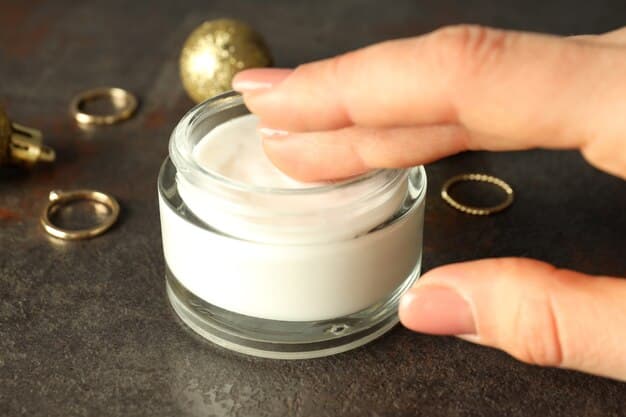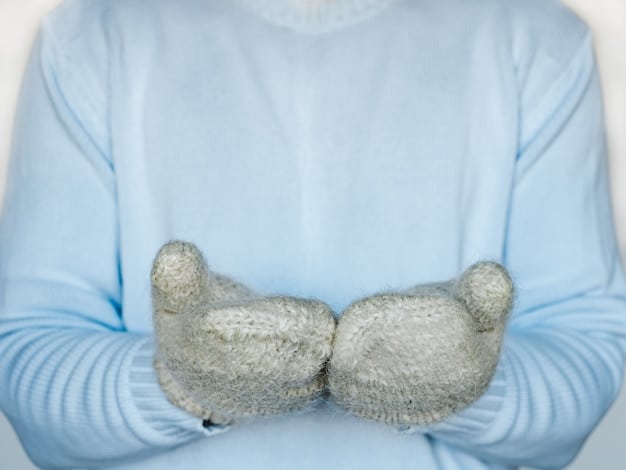Winter Skincare Survival: Expert Tips for a Healthy Glow in January

Navigating the harsh realities of winter dryness demands a proactive skincare strategy focused on intense hydration, barrier protection, and targeted treatments, ensuring your skin maintains its natural luminosity and health even through the coldest January days.
As the chill of January sets in, many of us notice our skin reacting to the dramatic shift in weather. From dry, flaky patches to an overall dullness, the winter months can be brutal on our complexions. Achieving Winter Skincare Survival: Expert Tips to Combat Dryness and Maintain a Healthy Glow Through January is not merely about enduring the cold; it’s about transforming your routine to thrive. This guide delves into actionable strategies, separating fact from fiction, to help your skin not just survive, but truly glow, even in the harshest winter conditions.
Understanding Winter’s Impact on Your Skin
Winter brings a complex set of challenges for our skin, far beyond just the cold air itself. The environment transforms into a moisture-stripping adversary, affecting even those who typically boast resilient complexions. It’s crucial to understand these underlying mechanisms rather than simply reacting to symptoms, laying the groundwork for truly effective skincare strategies.
The primary culprit is the dramatic drop in humidity levels, both outdoors and indoors. Outside, cold air holds significantly less moisture than warm air, leading to a direct syphoning of water from your skin’s surface. Indoor heating systems, while providing essential warmth, exacerbate this by circulating dry, warmed air that acts like a sponge, drawing moisture from everything in its path, including your skin. This constant battle against dryness compromises the skin’s natural barrier, leading to increased transepidermal water loss (TEWL). When the skin barrier is impaired, it becomes less effective at retaining moisture and more vulnerable to external irritants, setting off a cascade of issues from redness and flaking to heightened sensitivity.
The Role of the Skin Barrier
The skin barrier, primarily the stratum corneum, is our body’s first line of defense, a complex blend of dead skin cells and lipids working in harmony like a brick wall and mortar. In winter, this delicate structure is under immense stress. Low humidity causes these “bricks” and “mortar” to shrink and crack, creating microscopic fissures that allow precious moisture to escape and environmental aggressors to sneak in. This disruption doesn’t just lead to dryness; it can also trigger or worsen conditions like eczema, psoriasis, and rosacea, making the skin itchy, inflamed, and uncomfortable.
Furthermore, long, hot showers or baths, a tempting refuge from the winter cold, can strip the skin of its natural oils, weakening the barrier even further. Many people instinctively turn up the heat, unaware that this temporary comfort often leads to prolonged discomfort for their skin. This is why understanding the full spectrum of winter’s impact is the first essential step in building a robust winter skincare survival plan. It’s about recognizing that the solutions must be as multifaceted as the problems themselves, focusing on replenishment, protection, and gentle care to restore and maintain the skin’s vital functions.
Hydration Heroes: Essential Ingredients for Dry Winter Skin
When the air turns crisp and dry, your usual light moisturizer might not cut it. Winter demands a strategic shift towards ingredients that are not just hydrating but deeply nourishing and barrier-supportive. Navigating the world of skincare ingredients can be daunting, but focusing on a few key “hydration heroes” will make all the difference in combating dryness and maintaining a healthy glow through January. These ingredients work synergistically to replenish lost moisture, fortify the skin’s protective barrier, and soothe irritation.
First and foremost, humectants are non-negotiable. These ingredients act like magnets, drawing water from the air (if humidity permits) and deeper layers of the skin to the surface.
- Hyaluronic Acid: Perhaps the most celebrated humectant, hyaluronic acid can hold up to 1,000 times its weight in water, providing intense surface hydration. Look for products with multiple molecular weights for multi-depth hydration.
- Glycerin: A classic humectant, glycerin is highly effective and well-tolerated by all skin types. It’s a foundational hydrating ingredient found in many effective winter formulas.
- Urea: Beyond its humectant properties, urea also has mild exfoliating capabilities at higher concentrations, helping to shed dead, flaky skin while simultaneously hydrating.
Next, emollients are crucial for smoothing and softening the skin, filling in the cracks between dry skin cells. They also help improve the skin’s texture and overall comfort.
- Ceramides: These are lipids naturally found in our skin barrier. Replenishing ceramides is vital for repairing and strengthening the compromised barrier, reducing moisture loss.
- Fatty Acids (e.g., Linoleic Acid, Oleic Acid): Essential components of the skin’s lipid matrix, they support barrier function and provide deep nourishment.
- Cholesterol: Another key lipid found in the skin barrier, it works synergistically with ceramides and fatty acids to fortify the skin’s protective layer.
Finally, occlusives form a protective seal on the skin’s surface, preventing transepidermal water loss (TEWL). They lock in all the hydration and nourishment provided by humectants and emollients.
- Squalane: A lightweight, stable oil that mimics the skin’s natural sebum, squalane is an excellent emollient and mild occlusive.
- Shea Butter: Rich in fatty acids and vitamins, shea butter is a superb emollient and occlusive, providing intense moisturization and protection.
- Petroleum Jelly (e.g., Vaseline): The gold standard occlusive, it creates a highly effective barrier to prevent moisture evaporation. While it might feel heavy, it’s incredibly effective for very dry or compromised skin.
When choosing products, prioritize formulas that combine these different types of ingredients. For example, a moisturizer might contain hyaluronic acid for hydration, ceramides for barrier repair, and shea butter for occlusion. By understanding the role of each “hydration hero,” you can build a more effective winter skincare routine tailored to your skin’s specific needs, ensuring it remains plump, smooth, and radiant even in the deepest winter.
Strategic Cleansing: The Foundation of Winter Skincare
Cleansing is undoubtedly the first step in any skincare routine, but in winter, it transforms from a simple act into a strategic decision. The wrong cleanser can strip your skin of its already precious natural oils, exacerbating dryness and sensitivity. Therefore, choosing a cleanser that respects your skin’s delicate balance is paramount for Winter Skincare Survival. The goal is to remove impurities and makeup without compromising the skin’s natural barrier.
Opt for creamy, milky, or oil-based cleansers over foaming or gel formulas, especially those containing harsh sulfates. Foaming agents, while effective at creating a lather, can often be too aggressive for dry or sensitive winter skin, leaving it feeling tight and uncomfortable. Cream cleansers, on the other hand, are designed to cleanse gently while imparting a layer of moisture, making them ideal for colder months. Oil cleansers, typically used as a first step in a double-cleansing routine, dissolve makeup and sunscreen without stripping native lipids, providing a gentle yet thorough cleanse that preserves the skin’s moisture.
The Art of Gentle Cleansing
Beyond the product itself, the method of cleansing plays a significant role. Hot water feels delightful on a cold day, but it is an enemy to your skin barrier. Super-hot water strips natural oils, leaving the skin parched and vulnerable. Instead, use lukewarm water for both cleansing and rinsing. This temperature is effective enough to wash away impurities without causing excessive lipid loss. When applying cleanser, use light, circular motions with your fingertips, avoiding harsh scrubbing or abrasive tools like stiff brushes, which can create micro-tears and further compromise the barrier.
Pat your skin dry with a soft towel immediately after cleansing, rather than rubbing. Leaving the skin slightly damp before applying your toner, serum, or moisturizer is a common expert tip, as it helps to trap additional moisture into the skin. This immediate application of treatment products onto damp skin enhances their absorption, making them more effective at delivering their hydrating and nourishing ingredients. By being mindful of both the type of cleanser you use and your cleansing technique, you lay a healthy foundation for the rest of your winter skincare routine, ensuring your skin remains calm, hydrated, and ready to absorb the subsequent beneficial layers.
Layering for Maximum Efficacy: A Winter Skincare Ritual
The concept of layering skincare products is not new, but in winter, it becomes an art form crucial for maximizing efficacy and providing optimal protection against dryness. Like dressing in layers to stay warm, applying skincare in a strategic sequence allows each product to deliver its benefits while preparing the skin for the next, ultimately sealing in moisture and reinforcing the skin’s barrier. This ritual is particularly important for Winter Skincare Survival, ensuring every precious drop of hydration counts.
Begin with the lightest products first and progress to the heaviest. After gentle cleansing, the first active layer is typically a toner or essence. These watery formulations help to balance the skin’s pH, remove any lingering impurities, and, most importantly, provide an initial boost of hydration, making the skin more receptive to subsequent treatments. Look for hydrating toners free of alcohol, which can be drying. Ingredients like rose water, hyaluronic acid, or ceramides in toners are excellent choices for winter.
The Power of Serums and Oils
Next comes the serum, often the most concentrated and treatment-oriented step in your routine. Serums are packed with active ingredients designed to target specific concerns, such as dryness, dullness, or fine lines. For winter, prioritize serums rich in humectants like hyaluronic acid, or those containing antioxidants (Vitamin C, E) and barrier-repairing ingredients (ceramides, niacinamide). Apply serums to slightly damp skin to enhance absorption. Allow each serum to fully absorb for a minute or two before moving on.
After your serums, consider incorporating a facial oil. While often mistakenly thought to be only for oily skin, facial oils are incredibly beneficial in winter for all skin types, including combination and even oily, when chosen carefully. Oils provide a rich blend of fatty acids and vitamins that nourish the skin and act as a supporting occlusive layer. They help to strengthen the skin’s lipid barrier, reducing moisture loss. Choose non-comedogenic oils like squalane, argan, or rosehip oil. Apply a few drops by pressing them into the skin rather than rubbing aggressively. This gentle application helps the oil penetrate effectively.
The final and arguably most critical layer is your moisturizer, followed by an occlusive if your skin is particularly dry or compromised. The moisturizer acts as the ultimate hydrator and emollient, while the occlusive (which could be a very thick cream, balm, or even petroleum jelly) creates a protective seal. This top layer prevents the evaporation of all the beneficial ingredients applied beneath, locking in moisture and strengthening the skin’s defenses against the harsh winter elements. By mastering this layering technique, your skin will be thoroughly nourished, hydrated, and protected, radiating a healthy glow even when outside temperatures plummet.
Beyond the Basics: Lifestyle Adjustments for Winter Skin Health
While a dedicated skincare routine is fundamental, achieving complete Winter Skincare Survival extends far beyond topical applications. Your lifestyle choices, seemingly unrelated to your complexion, play a significant role in your skin’s overall health and resilience during the colder months. Integrating simple adjustments into your daily habits can amplify the benefits of your skincare products, helping to combat dryness and maintain that coveted healthy glow through January.
One of the most impactful adjustments is to monitor and increase indoor humidity. As previously mentioned, indoor heating systems drastically reduce moisture in the air. Placing humidifiers in key areas of your home, such as your bedroom and living space, can counteract this drying effect. Maintaining an indoor humidity level of 40-60% helps prevent your skin (and nasal passages) from losing moisture to the surrounding air, significantly reducing dryness and irritation. This passive hydration method provides continuous benefit throughout the day and night.
Nutritional Support and Hydration from Within
Your diet and water intake are equally crucial. Just as you hydrate your skin from the outside, it’s vital to hydrate from within. Increase your daily water consumption, even if you don’t feel as thirsty as in warmer months. Dehydration can manifest as dull, tight skin, exacerbating winter dryness. Additionally, incorporate foods rich in healthy fats and antioxidants into your diet. Omega-3 fatty acids, found in fatty fish, flaxseeds, and walnuts, support the skin’s lipid barrier and reduce inflammation. Foods high in vitamins A, C, and E (e.g., colorful fruits and vegetables) provide antioxidant protection, combating oxidative stress and promoting overall skin health.
Avoid excessively hot baths and showers, however tempting they may be. While a warm soak can be comforting, prolonged exposure to scalding water strips the skin of its natural oils, leaving it vulnerable to dryness and irritation. Opt for shorter, lukewarm showers and apply moisturizer immediately after, ideally within three minutes of stepping out, to lock in moisture while your skin is still damp. Furthermore, consider protecting your skin from direct exposure to harsh winter winds and cold. Scarves, hats, and gloves aren’t just fashion accessories; they act as physical barriers against environmental stressors, preventing chapping and windburn on exposed skin. These holistic lifestyle adjustments, woven into your daily routine, provide comprehensive support, ensuring your skin thrives amidst winter’s challenges.
Addressing Specific Winter Skin Concerns
Even with a robust general winter skincare routine, the season can bring about specific, stubborn concerns that require targeted attention. From persistent flaky patches to heightened sensitivity and the dreaded winter dullness, recognizing and addressing these issues head-on is key to achieving true Winter Skincare Survival and maintaining a radiant complexion through January.
Combatting Dry, Flaky Patches and Itchiness
When the skin is severely dry, it often manifests as flaky patches, particularly around the nose, mouth, and on the forehead. This is a sign of extreme transepidermal water loss and impaired barrier function. For these areas, consider “slugging” – applying a thin layer of an occlusive like petroleum jelly or a thick balm (e.g., Aquaphor) as the last step in your nighttime routine. This creates an impenetrable barrier that locks in moisture and helps the skin repair itself overnight. For persistent itchiness, look for products containing soothing ingredients like colloidal oatmeal, allantoin, or panthenol (Vitamin B5), which help calm irritation and reduce redness. Over-the-counter hydrocortisone cream can be used for very localized, severe itching, but sparingly and under professional guidance.
Managing Winter Redness and Sensitivity
Many people experience increased redness and sensitivity in winter due to the harsh environmental conditions compromising the skin barrier. This can be particularly challenging for those with conditions like rosacea. To manage this, simplify your routine and focus on gentle, fragrance-free products. Avoid harsh exfoliants (physical scrubs or high concentrations of alpha-hydroxy acids) that can further irritate sensitized skin. Instead, incorporate ingredients known for their calming and anti-inflammatory properties, such as niacinamide, centella asiatica (Cica), or green tea extract. These can help strengthen the skin barrier and reduce inflammatory responses. Using a rich, restorative balm or an emollient cream designed for sensitive skin can also provide a protective layer against environmental triggers.
Finally, winter often leaves skin looking dull and lackluster due to a buildup of dead skin cells and reduced blood circulation. While harsh exfoliation is to be avoided, gentle exfoliation is still beneficial to reveal brighter skin. Opt for very mild chemical exfoliants (e.g., low-concentration lactic acid or poly-hydroxy acids like PHA) once or twice a week, or a gentle enzyme exfoliant. These work to dissolve dead skin cells without scrubbing. Increasing hydration from within and ensuring adequate sleep also significantly contribute to a brighter, healthier complexion. By understanding these common winter skin dilemmas and applying targeted solutions, you can prevent minor issues from becoming major concerns, keeping your skin healthy and glowing.

Common Pitfalls to Avoid in Winter Skincare
Even with the best intentions, it’s easy to fall into common traps that can inadvertently worsen winter skin woes. Navigating the pitfalls is as crucial as knowing the right steps for effective Winter Skincare Survival. By identifying and avoiding these mistakes, you can prevent unnecessary irritation, dryness, and discomfort, ensuring your skin remains healthy and radiant through January.
One of the most frequently made mistakes is over-exfoliation. In an attempt to rid the skin of dry, flaky patches, many people reach for harsh physical scrubs or strong chemical exfoliants more frequently than their skin can handle. While exfoliation is essential to remove dead skin cells and promote cell turnover, doing too much, or using products that are too aggressive, can severely compromise the skin barrier. This leads to increased dryness, redness, sensitivity, and even breakouts. Instead, reduce the frequency of exfoliation (perhaps once or twice a week) and opt for gentler methods, such as enzyme exfoliants or mild alpha-hydroxy acids (like lactic acid) at lower concentrations.
Ignoring Sun Protection
Another critical oversight is neglecting sun protection. Just because it’s cold and cloudy doesn’t mean UV radiation isn’t a threat. UVA rays, which contribute to premature aging and skin damage, penetrate clouds and windows year-round. Furthermore, snow can reflect up to 80% of UV rays, essentially doubling your exposure. Failing to apply a broad-spectrum sunscreen with an SPF of at least 30 daily, even on overcast days, leaves your skin vulnerable to damage, which can exacerbate existing issues and delay healing. Make sunscreen the non-negotiable final step in your morning routine, regardless of the weather.
Using products with harsh ingredients is another common pitfall. Many skincare products contain ingredients like denatured alcohol, strong fragrances, or certain essential oils that can be irritating or drying, especially for already compromised winter skin. Always check ingredient lists and opt for fragrance-free, alcohol-free formulations, particularly for cleansers and moisturizers. Even seemingly minor irritants can add up and lead to significant discomfort when your skin barrier is weakened. Finally, neglecting the skin on your body is a major mistake. While facial skincare often takes center stage, the skin on your body, especially on your hands, legs, and décolletage, is equally susceptible to winter dryness. Extend your hydrating routine to your entire body using rich body creams, balms, and hand creams. Integrating these preventative measures into your winter skincare strategy can significantly improve your skin’s health and comfort, making the colder months much more manageable.

Embracing a Holistic Approach for Year-Round Skin Wellness
Achieving Winter Skincare Survival and maintaining a healthy glow through January isn’t just a seasonal sprint; it’s an opportunity to embrace a more holistic approach to skin wellness that benefits you year-round. The harsh realities of winter simply highlight the importance of practices that nurture your skin from the inside out and protect it from environmental stressors, setting a precedent for robust skin health regardless of the climate.
Developing a deep understanding of your skin’s needs, rather than blindly following trends, is paramount. Just as winter dictates a shift towards richer, more protective formulations, other seasons will call for their own adjustments. Learning to “read” your skin – noticing how it reacts to different products, environmental factors, and even stress – empowers you to make informed decisions about its care. This intuitive understanding ensures your routine remains adaptive and effective, preventing issues before they escalate.
This holistic view extends to recognizing the interconnectedness of skin health with overall well-being. Adequate sleep, a balanced diet rich in antioxidants and healthy fats, consistent hydration, and stress management are not merely fringe benefits; they are foundational pillars of radiant skin. When these internal systems are in balance, your skin reflects that vitality, demonstrating greater resilience and a natural luminosity that no topical product alone can replicate. The disciplined care required to combat winter dryness can easily translate into year-round habits that proactively support your skin’s health.
The journey through winter skincare teaches us the critical role of barrier protection and gentle care. These principles are not exclusive to cold weather; a healthy, intact skin barrier is your ultimate defense against pollution, irritants, and even the natural aging process, regardless of the season. By focusing on maintaining barrier integrity, avoiding harsh treatments, and consistently nourishing your skin, you build a resilient foundation. This means investing in quality, multi-functional products that support barrier function and integrating calming ingredients that keep inflammation at bay. Ultimately, the lessons learned in managing January’s chill provide a powerful blueprint for cultivating strong, healthy, and glowing skin throughout every season, transcending the temporary challenges of winter into a lasting commitment to skin wellness.
| Key Aspect | Brief Description |
|---|---|
| 💧 Targeted Hydration | Focus on humectants (HA, glycerin) and occlusives (squalane, petroleum jelly) to lock in moisture and prevent transepidermal water loss. |
| 🛡️ Barrier Protection | Use ceramides, fatty acids, and cholesterol to repair and strengthen the skin’s natural barrier against harsh winter elements. |
| ✅ Gentle Care | Opt for creamy cleansers, lukewarm water, and mild exfoliation to avoid stripping natural oils and causing irritation. |
| 🏡 Environmental Control | Utilize humidifiers indoors and protect skin with scarves/hats outdoors to reduce moisture loss and physical irritation. |
Frequently Asked Questions About Winter Skincare
▼
Winter air has low humidity, both outdoors and indoors with heating, which actively pulls moisture from your skin. Even with moisturizing, if products lack occlusives or your skin barrier is compromised, water evaporates quickly. Ensuring your moisturizer has humectants, emollients, and occlusives, and strengthening your barrier with ceramides, is crucial.
▼
Absolutely. Many foaming or gel cleansers can be too stripping for winter. Switch to creamy, milky, or oil-based cleansers that remove impurities without stripping natural oils. This helps maintain your skin’s protective barrier, which is essential when environmental humidity is low and your skin is more vulnerable to dryness.
▼
Yes, but gently and less frequently. Over-exfoliation can compromise your already vulnerable skin barrier in winter. Opt for mild chemical exfoliants (like PHAs or low-concentration lactic acid) or enzyme exfoliants once or twice a week, rather than harsh physical scrubs. This removes dead skin cells without causing irritation, allowing better product absorption.
▼
The best approach for chapped lips involves consistent care. Use a gentle lip balm with ingredients like shea butter, lanolin, or beeswax. Apply it frequently throughout the day, especially before bed. Avoid licking your lips, as saliva evaporates and can worsen dryness. For severe cases, a thin layer of petroleum jelly overnight can be highly effective.
▼
Yes, unequivocally. UVA rays, responsible for aging and skin damage, penetrate clouds and windows year-round. Snow also reflects up to 80% of UV radiation, increasing your exposure. Applying a broad-spectrum SPF 30+ daily is essential to protect your skin from sun damage, even on cloudy or snowy winter days.
Conclusion
Navigating the colder months, especially through January, presents unique challenges for skin health, demanding a strategic and comprehensive approach. Achieving Winter Skincare Survival: Expert Tips to Combat Dryness and Maintain a Healthy Glow Through January is not just about adding an extra layer of moisturizer; it’s about understanding the nuances of winter’s impact and adapting your routine accordingly. By prioritizing gentle cleansing, leveraging hydration heroes like humectants and occlusives, mastering the art of layering, and implementing crucial lifestyle adjustments, you can transform your skin’s resilience. The insights shared herein offer a roadmap not only for enduring the winter but for emerging with a complexion that truly radiates health and luminosity, proving that mindful skincare transcends seasonal shifts to foster year-round wellness.





